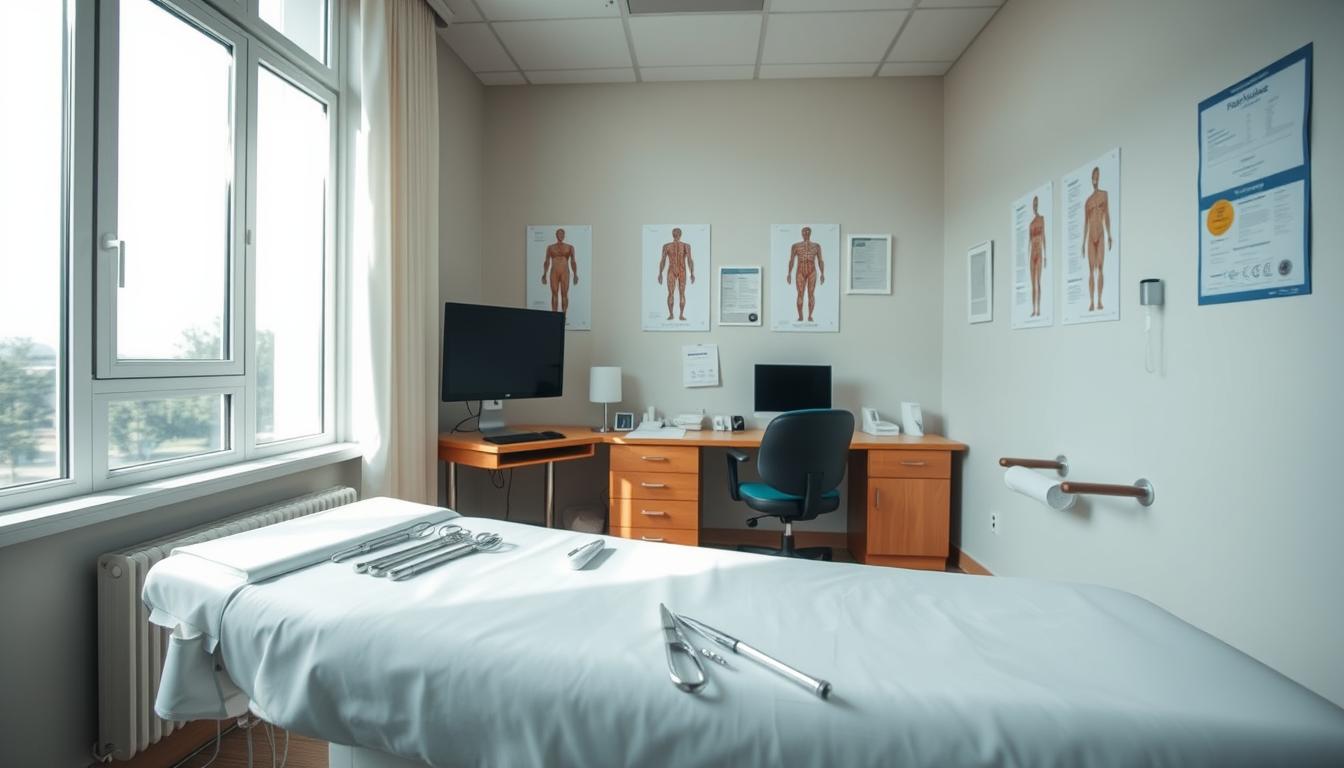Staying on top of your health is essential, and understanding the expiration rules for physical exams is a key part of that. Whether it’s for work, school, or sports, knowing when your exam is due ensures you remain compliant and healthy.
Expiration periods vary widely. For example, DOT exams are valid for 24 months, while Illinois requires sports physicals every 395 days. Texas, on the other hand, mandates them every two years. These differences highlight the importance of checking local and industry-specific requirements.
According to Acuity International’s Chief Medical Officer, chronic conditions may shorten the validity of certain physical exams. This makes it crucial to stay informed and proactive about your health needs.
Key Takeaways
- Expiration periods for physical exams vary by type and location.
- DOT physicals are valid for 24 months.
- Illinois requires sports physicals every 395 days.
- Chronic conditions may reduce the validity of certain exams.
- Always check local and industry-specific requirements.
Introduction to Physical Examinations
Physical exams are a cornerstone of preventive health measures. They serve as essential tools for employers, athletes, and schools to ensure safety and well-being. These assessments not only evaluate current health but also establish medical baselines for future reference.
In high-risk industries, such as trucking, construction, and firefighting, physical exams are mandatory. OSHA’s General Duty Clause requires fitness evaluations for hazardous jobs, ensuring workers are fit for duty. This proactive approach reduces workplace injuries by 23% and cuts absenteeism by 18% in DOT-regulated industries.
Physical exams also play a dual role. They identify existing conditions and provide a foundation for ongoing care. By reviewing medical history, healthcare providers can detect potential risks early, preventing complications down the line.
Here are some key benefits of regular physical examinations:
- Preventive tool for employers, athletes, and schools.
- Establishes medical baselines for future health assessments.
- Mandatory in high-risk industries like trucking and construction.
- Reduces workplace injuries and absenteeism.
By prioritizing physical exams, individuals and organizations can maintain health, safety, and compliance with industry standards.
What Is the Purpose of a Physical Exam?
Understanding the purpose of a physical examination helps you stay proactive about your health. These exams are designed to assess your overall well-being and detect potential issues early. Whether for work, sports, or general health, they play a vital role in maintaining safety and compliance.
Workplace Physicals
Workplace physicals ensure employees are fit for their roles, especially in high-risk industries. For commercial drivers, compliance with FMCSA §391.41-49 is mandatory. These exams often detect conditions like hypertension, found in 32% of truckers during DOT exams.
Strength and stamina assessments are also part of these evaluations. They help prevent workplace accidents by ensuring employees can handle physical demands. Regular workplace physicals reduce injuries and improve productivity.
Sports Physicals
Sports physicals focus on assessing an athlete’s readiness for physical activity. They help identify potential risks, such as heart conditions, which are critical for safety. Studies show that 89% of sports-related cardiac arrests are detected during pre-participation exams.
These exams also evaluate blood pressure and overall health. By addressing issues like diabetes or other chronic conditions, they ensure athletes can perform safely and effectively.
| Type of Physical | Key Focus Areas | Benefits |
|---|---|---|
| Workplace Physicals | Compliance, strength, stamina | Reduces workplace accidents |
| Sports Physicals | Heart health, blood pressure | Prevents sports-related injuries |
How Long Do Physicals Last? Understanding the Expiration Rules
Expiration dates for physical exams vary based on type and location. Staying informed about these rules ensures you remain compliant and proactive about your health. Whether for work, sports, or general wellness, knowing when to renew your exam is essential.
DOT Physicals
DOT physicals are required for commercial drivers and have a baseline validity of 24 months, as per 49 CFR §391.43. However, certain conditions can shorten this period. For example, drivers with insulin-treated diabetes must renew their certification every six months.
Hypertension also affects exam validity. If blood pressure exceeds 140/90, drivers may need recertification every 3-6 months. Medical examiners have discretion for hypertension stages 1-2, ensuring drivers meet safety standards.
State-Specific Rules
State regulations add another layer of complexity. For instance, Illinois requires sports physicals every 395 days, while Texas mandates them every two years. These variations highlight the importance of checking local requirements.
In some cases, additional lab tests may be required based on state or industry standards. Staying updated on these rules helps avoid lapses in compliance.
- DOT physicals are valid for 24 months, with exceptions for specific conditions.
- Hypertension and diabetes can shorten exam validity periods.
- State rules vary, with some requiring exams every 395 days or two years.
- Additional lab tests may be necessary based on local regulations.
Types of Physical Exams
Different types of physical exams cater to specific health and occupational needs. Whether you’re preparing for a new job or maintaining your annual health routine, understanding these exams ensures you stay proactive about your well-being.
Annual Physicals
An annual physical is a comprehensive health checkup designed to monitor your overall wellness. These exams often include laboratory tests to assess blood sugar, cholesterol, and other vital markers. The USPSTF recommends lipid panels every five years starting at age 35.
Blood pressure screening frequency varies by age. For individuals under 40, screenings are advised every two years. For those over 40, annual screenings are recommended. Seniors may also require additional assessments, such as cognitive impairment screening, to ensure comprehensive care.
Medicare Wellness Visits are a cost-effective alternative to comprehensive physicals. However, they focus more on preventive care and less on detailed diagnostics. Understanding these differences helps you choose the right option for your needs.
Pre-Employment Physicals
Pre-employment physicals ensure candidates are fit for specific job roles. These exams often include strength and stamina assessments, especially for physically demanding jobs. Employers use these evaluations to reduce workplace injuries and improve productivity.
Some roles may require additional tests, such as drug screenings or specialized laboratory tests. By meeting these requirements, candidates demonstrate their readiness for the job while employers ensure compliance with safety standards.
| Type of Exam | Key Components | Purpose |
|---|---|---|
| Annual Physical | Blood pressure, cholesterol, cognitive screening | Monitor overall health and detect potential issues |
| Pre-Employment Physical | Strength, stamina, drug screening | Ensure fitness for specific job roles |
What to Expect During a Physical Exam
A physical exam is a thorough health assessment designed to evaluate your well-being. It involves a series of steps to check your overall health and detect potential issues early. Whether for work, sports, or general wellness, understanding the process can help you feel more prepared.
Vital Signs and Laboratory Tests
One of the first steps in a physical exam is checking your vital signs. These include blood pressure, heart rate, and oxygen levels. Normative ranges for these measurements are:
- Blood pressure:
- Oxygen saturation (SpO2): >95%
- Body Mass Index (BMI): 18.5-24.9
Laboratory tests are also common. These may include lipid panels and glucose checks. Fasting is often required—12 hours for lipid panels and 8 hours for glucose tests. These tests help identify risks for conditions like heart disease or diabetes.
Industry-Specific Assessments
Certain jobs require specialized evaluations. For example, OSHA’s 29 CFR 1910.95 mandates annual audiograms for workers exposed to noise levels above 85 dB. This ensures hearing protection and compliance with safety standards.
Other assessments may include strength tests, reflexes checks, and evaluations of organ function, such as the liver. These tailored exams ensure workers are fit for their roles and reduce workplace risks.
Regular physical exams are a cornerstone of preventive care, helping individuals stay healthy and compliant with industry standards.
For more insights on maintaining your health, explore these preventive measures that can make a significant difference in your well-being.
How to Prepare for a Physical Exam

Proper preparation for a physical exam ensures a smooth and efficient process. Gathering the right documents and following pre-exam guidelines can help you avoid delays and ensure accurate results. Whether for work, sports, or general health, being prepared is key.
Documents to Bring
Bringing the correct paperwork is essential. For CDL holders, this includes your current medical certificate, exemption certificates, and CPAP compliance reports if applicable. In Illinois, athletes must complete the IHSA Preparticipation Exam (Form 77-0096).
Acuity case studies show that 68% of failed DOT exams result from improper documentation. Double-check your medical history and ensure all required forms are complete. This step saves time and prevents unnecessary retesting.
Pre-Exam Guidelines
Follow specific guidelines to ensure accurate results. If your exam includes lab tests, you may need to fast for 8-12 hours beforehand. Avoid alcohol and strenuous activities 24 hours prior to the exam.
Make a list of your current medications and dosages. This information helps your healthcare provider assess your health accurately. Staying hydrated and wearing comfortable clothing also contributes to a smoother experience.
- CDL holders: Bring medical certificates and compliance reports.
- Athletes: Complete required forms like IHSA Preparticipation Exam.
- Fasting: Follow guidelines for lab tests.
- Medications: List all current prescriptions.
What Happens After a Physical Exam?
After completing a physical exam, the next steps are crucial for maintaining health and compliance. Whether you’re cleared for work, sports, or receive health recommendations, understanding the process ensures you stay proactive about your well-being.
Cleared for Work or Sports
If your exam results meet the required standards, you’ll receive clearance for your intended activity. For workplace physicals, OSHA’s 29 CFR 1904.5 outlines recordable injury criteria that may impose restrictions. These ensure employees are fit for their roles and reduce workplace risks.
For athletes, the NCAA Division I clearance process involves a 6-step appeals protocol. This ensures fairness and safety in sports participation. Follow-up tests, such as spirometry, may be required in 22% of OSHA physicals to confirm respiratory health.
Health Recommendations
Your healthcare provider may offer tailored advice based on your exam results. For chronic conditions like diabetes, they might suggest dietary changes or regular monitoring. Exercise plans are often recommended to improve overall health and manage specific conditions.
Preventive care is a key focus. Regular check-ups and lifestyle adjustments can help you maintain optimal health. Staying informed about your condition and following professional advice ensures long-term well-being.
| Clearance Type | Key Criteria | Follow-Up Actions |
|---|---|---|
| Workplace Physicals | OSHA 29 CFR 1904.5 | Restrictions, spirometry tests |
| Sports Physicals | NCAA Division I Protocol | 6-step appeals process |
By understanding what happens after a physical exam, you can take the necessary steps to stay healthy and compliant. Regular follow-ups and adherence to recommendations ensure you maintain your well-being in the long run.
Why Regular Physicals Are Important

Investing in routine health checkups can lead to significant long-term benefits. Regular physical exams are not just about compliance; they are a proactive approach to maintaining overall well-being. By identifying potential issues early, these exams help prevent serious conditions and reduce healthcare costs over time.
Preventing Health Issues
Early detection is one of the most significant benefits of regular physicals. For example, 54% of prostate cancers are found through PSA screenings during routine exams. This early intervention can lead to more effective treatment and better outcomes.
Companies that implement annual physical programs see a 31% reduction in workers’ compensation claims. This highlights the financial and operational advantages of prioritizing employee health. A Harvard study also found that every $1 spent on wellness exams yields a $3.27 return on investment.
Compliance with Regulations
Regular physicals ensure compliance with industry and state-specific regulations. For instance, OSHA mandates annual health assessments for workers in high-risk environments. These exams help employers meet safety standards and reduce workplace injuries.
Staying updated on health requirements also prevents lapses in certifications. Whether for commercial drivers or athletes, compliance ensures uninterrupted participation in work or sports activities.
| Benefit | Impact |
|---|---|
| Early Detection | Identifies conditions like cancer and heart disease early |
| Cost Savings | $3.27 ROI for every $1 spent on wellness exams |
| Compliance | Meets OSHA and state-specific health requirements |
Conclusion
Understanding the validity periods for physical exams is essential for maintaining compliance and prioritizing your health. DOT exams remain valid for 24 months, while sports physicals typically require renewal every 12 months. OSHA mandates annual assessments for high-risk industries, ensuring safety and well-being.
State and jurisdictional variations add complexity to renewal timelines. For example, Illinois requires sports physicals every 395 days, while Texas follows a two-year cycle. Staying informed about these differences helps avoid lapses in certification.
Acuity International offers nationwide DOT-certified examiners and mobile exam units, reducing employer costs by 40%. Their efficient services ensure timely and compliant assessments for individuals and organizations alike.
Take proactive steps to schedule your next physical exam through acuityinternational.com. Prioritizing regular checkups ensures you stay healthy, compliant, and ready for any challenge.


